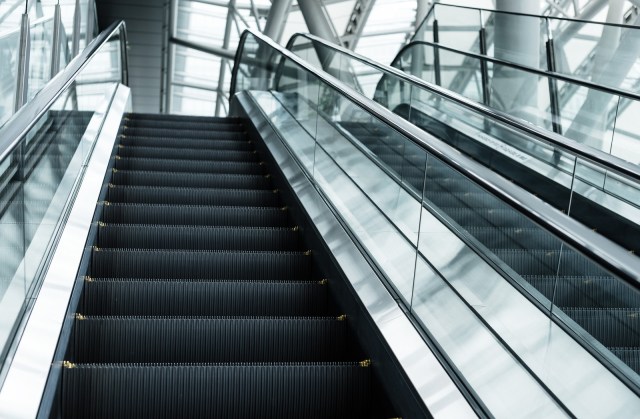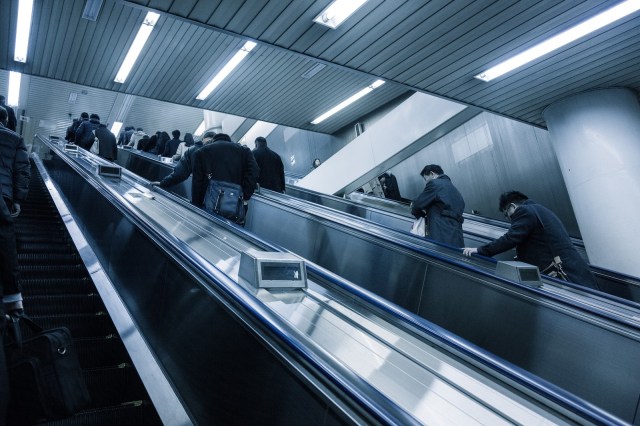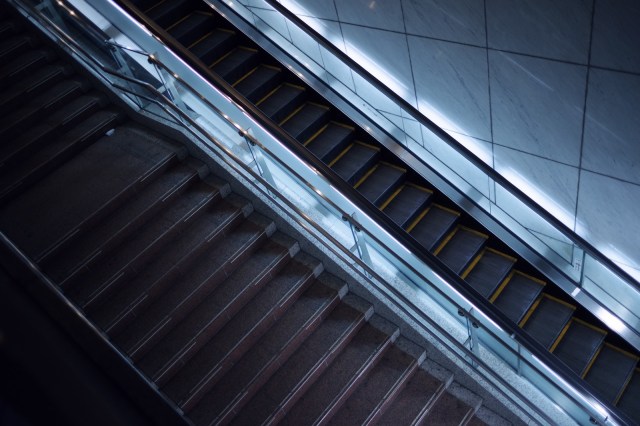
They’ve become the first prefecture in Japan to do so.
Masahiro Kawase is a 48-year-old office worker who suffered a stroke six years ago and is paralyzed on his left side. However, in Saitama Prefecture custom dictates that everyone who rides an escalator stands on the left and walks – or in some cases runs – up the right side.
This makes what ought to be a normal commute for Kawase a harrowing experience. When boarding the escalator he must grab the right side handrail, steady himself, then slide over to the right. He also must do all this before others shove him and shout at him to get out of the way.
Now, however, Kawase and others like him may find some relief in Saitama’s new ordinance that was passed on 26 March to prohibit any movement while riding escalators. The ordinance, which will take effect next October, also requires places with escalators to put signage asking riders to refrain from walking or running on the machines.
▼ As seen in this news report, some make-shift signs have already gone up, but people are still running
While consideration for people like Kawase is one of the motivating factors for this ordinance, Saitama is also hoping to help curb the roughly 775 escalator injuries that happen a year in Japan, a little over half of which are caused by not standing still and holding handrails.
NHK spoke with Edogawa University Professor Emeritus Masakazu Toki, who said that the custom began during the bubble era when work efficiency took precedence over consideration for weaker people. “Manners are usually created through people’s behavior and thinking,” said Professor Toki, “so it’s a little disappointing that this time they need to be stipulated in an ordinance. However, there have been calls for this for over 10 years and little has changed, so I appreciate that this was established. The ordinance respects autonomy rather than surveillance and penalties.”
As Prof. Toki said, like with other ordinances that made headlines in the past, there are no punishments for violating them. The goal instead is to put the matter at the forefront and hope people take the time to consider it and change their behavior accordingly. That might not sound so effective, but in some cases it has been enough to create significant change in the past.
Most comments about the news generally support not walking on escalators, but some people took issue with making a law out of it in this way.
“Next time I see someone blocking the escalator, I’ll know they’re from Saitama.”
“Great job Saitama! If you want to walk, use the stairs.”
“I don’t know. This problem won’t be solved until it’s nationwide.”
“I don’t really understand ordinances. What do they do?”
“I’m always worried when riding with my child that someone will rush by and knock them over. I hope this spreads.”
“I admit I run up sometimes, but I still think this is a good idea. If you can run, then you can use the stairs.”
“Just make all escalators wide enough for one person and watch the problem disappear.”
Changing all of the escalators in Japan is a solution, but probably more long-term than some people want to see. However, a similar effect might come about naturally anyway.
With Japan’s aging society where already one in four women is over 70, the balance of escalator climbers versus escalator riders will surely continue to shift. As Prof. Toki mentioned, the culture of escalator-climbing came about naturally at a time when the number of young business people rose sharply. Now, as we enter the age where the population is dominated by the elderly, what’s considered appropriate on escalators could also change naturally.
Source: NHK, My Game News Flash
Top image: Pakutaso
Insert images: Pakutaso (1, 2)
● Want to hear about SoraNews24’s latest articles as soon as they’re published? Follow us on Facebook and Twitter!



 Tokyo taking a stand on walking up and down escalators
Tokyo taking a stand on walking up and down escalators Japanese escalator cleaning crew discovers an absurd amount of change
Japanese escalator cleaning crew discovers an absurd amount of change Spiral escalators may be even more stylish than clothes at Japanese department store in Shanghai
Spiral escalators may be even more stylish than clothes at Japanese department store in Shanghai Tokyo farewells Japan’s only double-decker Shinkansen with a special escalator at the station
Tokyo farewells Japan’s only double-decker Shinkansen with a special escalator at the station Our Japanese writer discovers a surprising escalator in the US, declares America Best Place Ever
Our Japanese writer discovers a surprising escalator in the US, declares America Best Place Ever Japan’s new difficult-to-drink-from beer glass protects your liver, but it’s a brutal experience
Japan’s new difficult-to-drink-from beer glass protects your liver, but it’s a brutal experience How to order snacks on a Shinkansen bullet train in Japan
How to order snacks on a Shinkansen bullet train in Japan New Pokémon ice cream, dessert drinks, and cool merch coming to Baskin-Robbins Japan【Pics】
New Pokémon ice cream, dessert drinks, and cool merch coming to Baskin-Robbins Japan【Pics】 Demon Slayer: Kimetsu no Yaiba gets new roller coaster attractions and food at Universal Studios Japan
Demon Slayer: Kimetsu no Yaiba gets new roller coaster attractions and food at Universal Studios Japan New samurai glasses are Japan’s latest weird must-have souvenir
New samurai glasses are Japan’s latest weird must-have souvenir Doraemon found buried at sea as scene from 1993 anime becomes real life【Photos】
Doraemon found buried at sea as scene from 1993 anime becomes real life【Photos】 Hello, cosmetics! Clinique teams up with Hello Kitty this summer for first-time collaboration
Hello, cosmetics! Clinique teams up with Hello Kitty this summer for first-time collaboration To combat declining birth rate, Japan to begin offering “Breeding Visas” to foreigners
To combat declining birth rate, Japan to begin offering “Breeding Visas” to foreigners Nintendo history you can feel – Super NES, N64, and GameCube controllers become capsule toys
Nintendo history you can feel – Super NES, N64, and GameCube controllers become capsule toys This Nara workshop has been making deer crackers for more than 100 years and offers tours【Photos】
This Nara workshop has been making deer crackers for more than 100 years and offers tours【Photos】 “The most Delicious Cup Noodle in history” – Japan’s French Cup Noodle wins our heart【Taste test】
“The most Delicious Cup Noodle in history” – Japan’s French Cup Noodle wins our heart【Taste test】 Starbucks releases a cute Frappuccino and Unicorn Cake…but not in Japan
Starbucks releases a cute Frappuccino and Unicorn Cake…but not in Japan Kyoto Tower mascot termination reveals dark side behind cute Japanese characters
Kyoto Tower mascot termination reveals dark side behind cute Japanese characters McDonald’s Japan’s Soft Twist Tower: A phantom ice cream only sold at select branches
McDonald’s Japan’s Soft Twist Tower: A phantom ice cream only sold at select branches Yabai Ramen: What makes this Japanese ramen so dangerous?
Yabai Ramen: What makes this Japanese ramen so dangerous? Finally! Nintendo Japan expands Switch 8-bit controller sales to everybody, Online member or not
Finally! Nintendo Japan expands Switch 8-bit controller sales to everybody, Online member or not Japanese government wants to build luxury resorts in all national parks for foreign tourists
Japanese government wants to build luxury resorts in all national parks for foreign tourists 10 things you should buy at 7-Eleven in Japan
10 things you should buy at 7-Eleven in Japan Studio Ghibli releases anime heroine cosplay dresses that are super comfy to wear
Studio Ghibli releases anime heroine cosplay dresses that are super comfy to wear Woman charged for driving suitcase without a license in Osaka
Woman charged for driving suitcase without a license in Osaka Studio Ghibli unveils My Neighbour Totoro miniature house model
Studio Ghibli unveils My Neighbour Totoro miniature house model Kyoto experiencing problems with foreign tourists not paying for bus fares, but not on purpose
Kyoto experiencing problems with foreign tourists not paying for bus fares, but not on purpose Fighting mild hunger with a Japanese soda that turns into jelly in the stomach【Taste test】
Fighting mild hunger with a Japanese soda that turns into jelly in the stomach【Taste test】 Studio Ghibli’s Howl’s Moving Castle tapestry unveiled in Japan for first time
Studio Ghibli’s Howl’s Moving Castle tapestry unveiled in Japan for first time McDonald’s new Happy Meals offer up cute and practical Sanrio lifestyle goods
McDonald’s new Happy Meals offer up cute and practical Sanrio lifestyle goods Sales of Japan’s most convenient train ticket/shopping payment cards suspended indefinitely
Sales of Japan’s most convenient train ticket/shopping payment cards suspended indefinitely Sold-out Studio Ghibli desktop humidifiers are back so Totoro can help you through the dry season
Sold-out Studio Ghibli desktop humidifiers are back so Totoro can help you through the dry season Japanese government to make first change to romanization spelling rules since the 1950s
Japanese government to make first change to romanization spelling rules since the 1950s Foreigner’s request for help in Tokyo makes us sad for the state of society
Foreigner’s request for help in Tokyo makes us sad for the state of society Ghibli founders Toshio Suzuki and Hayao Miyazaki contribute to Japanese whisky Totoro label design
Ghibli founders Toshio Suzuki and Hayao Miyazaki contribute to Japanese whisky Totoro label design Tokyo’s most famous Starbucks is closed
Tokyo’s most famous Starbucks is closed Princesses, fruits, and blacksmiths: Study reveals the 30 most unusual family names in Japan
Princesses, fruits, and blacksmiths: Study reveals the 30 most unusual family names in Japan Japanese politicians want to make walking while looking at your smartphone illegal
Japanese politicians want to make walking while looking at your smartphone illegal 70-year-old arrested after brawl with over 10 bikers
70-year-old arrested after brawl with over 10 bikers This is what happens when a crowded escalator suddenly reverses【Video】
This is what happens when a crowded escalator suddenly reverses【Video】 Saitama senior arrested after calling telecom provider 24,000 times to complain
Saitama senior arrested after calling telecom provider 24,000 times to complain South Korea establishes special task force to combat escalators and elevators
South Korea establishes special task force to combat escalators and elevators American passenger on Tokyo flight arrested for biting flight attendant, says he doesn’t remember
American passenger on Tokyo flight arrested for biting flight attendant, says he doesn’t remember Genghis Khan-insulting manga pulled from major book stores amid further Mongolian protests
Genghis Khan-insulting manga pulled from major book stores amid further Mongolian protests NHK bill collector arrested for kissing woman on the job: “I thought we were hitting it off!”
NHK bill collector arrested for kissing woman on the job: “I thought we were hitting it off!” Convenience store clerk hospitalized by customer dissatisfied with “smile-less” service
Convenience store clerk hospitalized by customer dissatisfied with “smile-less” service The Petitcalator is Japan’s weirdest world record-holder in its most-forgotten big city【Videos】
The Petitcalator is Japan’s weirdest world record-holder in its most-forgotten big city【Videos】 “No ball games” & “No practicing comedy routines”: City Parks in Japan let you do less and less
“No ball games” & “No practicing comedy routines”: City Parks in Japan let you do less and less Singapore appears to have had a special place in David Bowie’s heart
Singapore appears to have had a special place in David Bowie’s heart Clever ad publicly shames commuters in real-time for “smartphone walking” in train station【Video】
Clever ad publicly shames commuters in real-time for “smartphone walking” in train station【Video】 Beijing to enact “Good Person Protection Ordinance”
Beijing to enact “Good Person Protection Ordinance” Thousands oppose Osaka Metro’s plan to change major stations in giant boats and fabric swatches
Thousands oppose Osaka Metro’s plan to change major stations in giant boats and fabric swatches
Leave a Reply